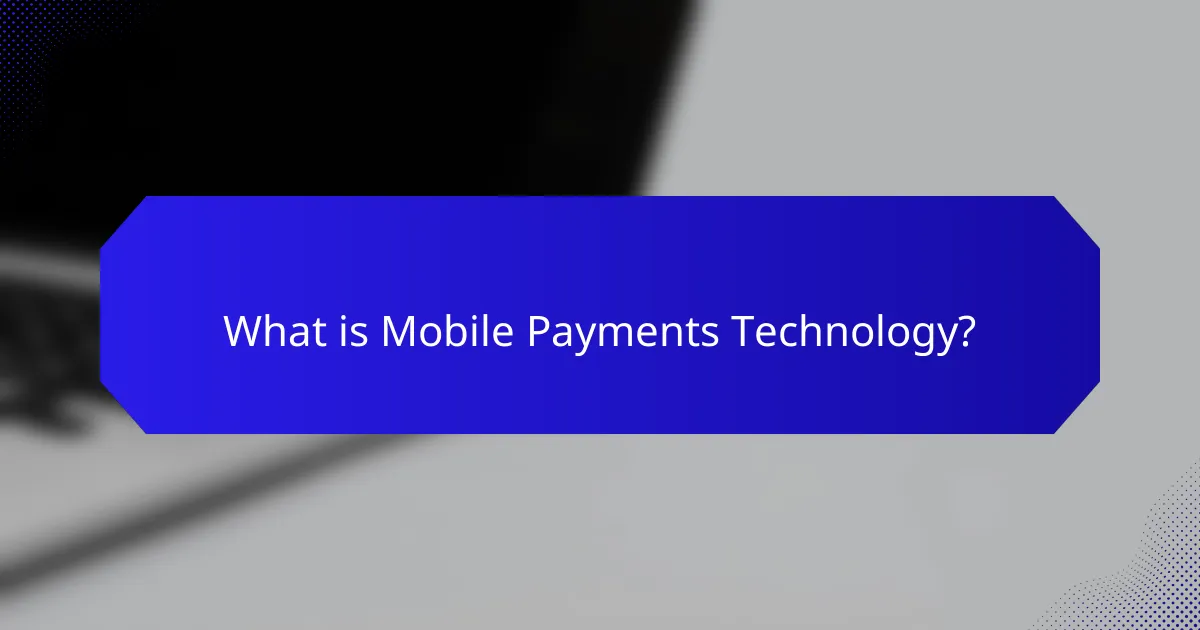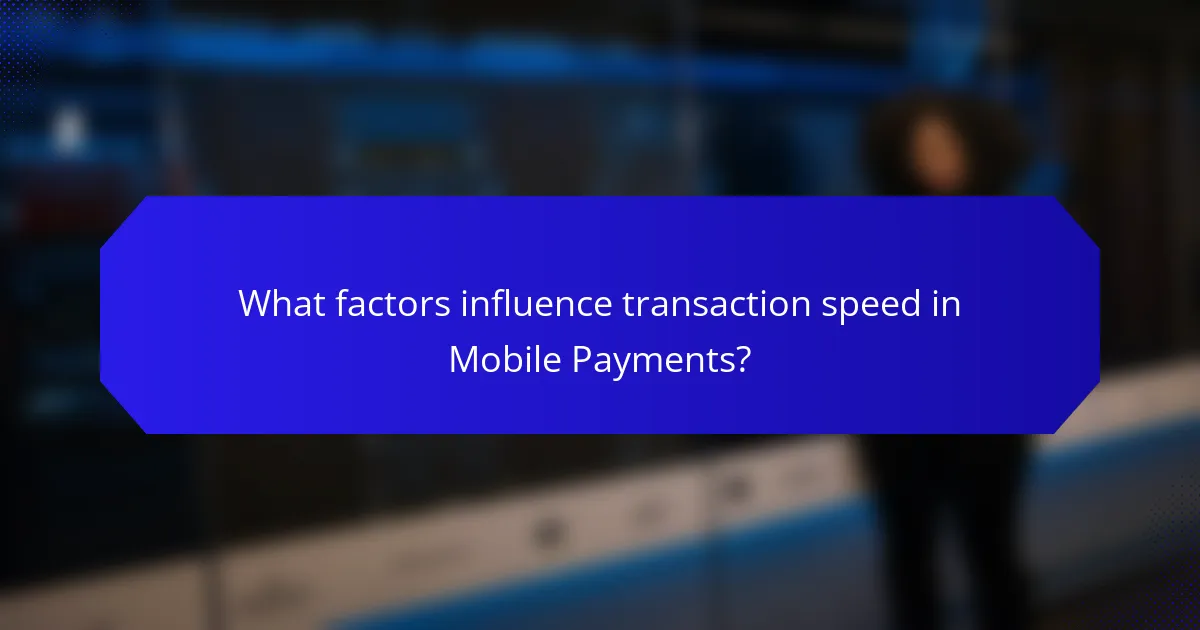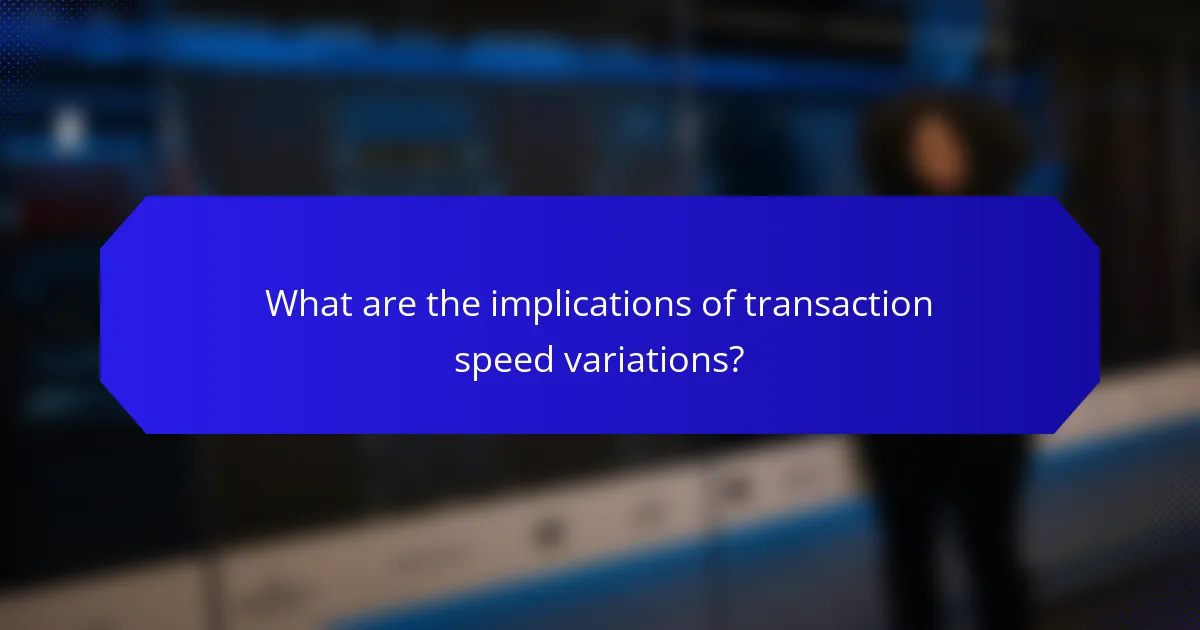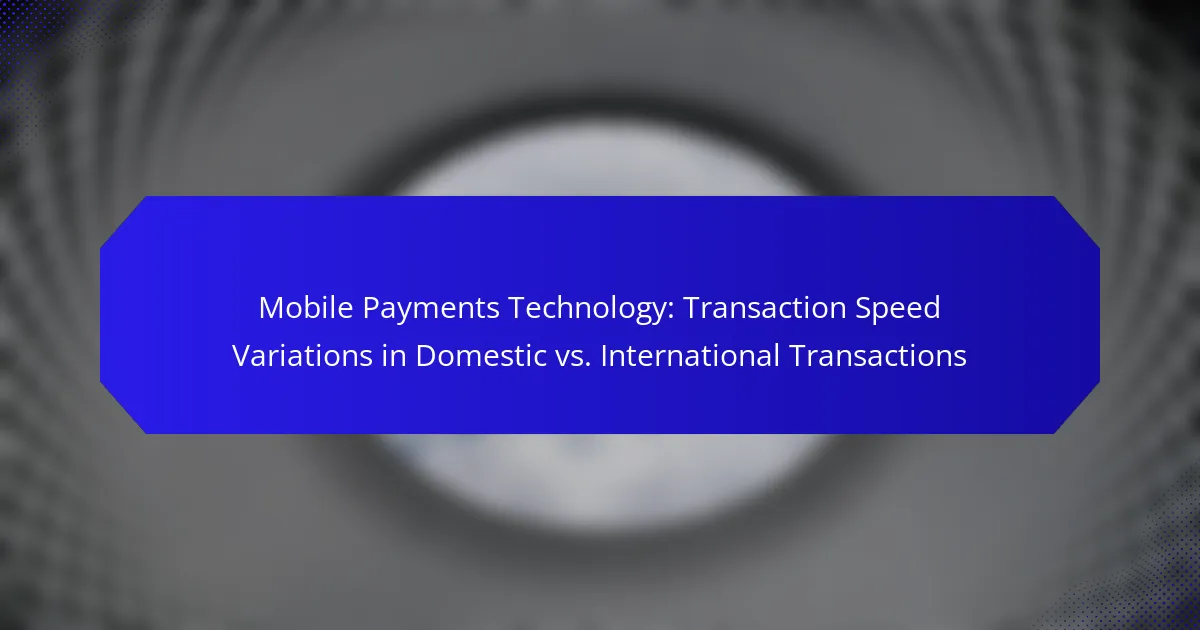Mobile payments technology encompasses systems that facilitate financial transactions through mobile devices, allowing users to make purchases, transfer funds, and pay bills securely via applications or digital wallets. The projected global transaction value for mobile payments is expected to exceed 12 trillion U.S. dollars by 2024, indicating a significant rise in adoption. This article examines the variations in transaction speed for mobile payments, specifically contrasting domestic and international transactions. Factors influencing transaction speed include network connectivity, payment processing systems, security protocols, transaction volume, payment methods, and geographical location. Understanding these variations is essential for enhancing user experience and operational efficiency in the mobile payments sector.

What is Mobile Payments Technology?
Mobile payments technology refers to the systems that enable financial transactions via mobile devices. This technology allows users to make purchases, transfer funds, and pay bills using smartphones or tablets. It typically involves applications or digital wallets that store payment information securely. According to Statista, mobile payment transaction value worldwide is projected to reach over 12 trillion U.S. dollars by 2024. This growth highlights the increasing adoption of mobile payments globally. Mobile payments can utilize technologies such as NFC (Near Field Communication) and QR codes for transaction facilitation.
How does Mobile Payments Technology function?
Mobile payments technology functions by enabling transactions through mobile devices. It utilizes near-field communication (NFC), QR codes, or mobile apps to facilitate payments. Users link their bank accounts or credit cards to a mobile wallet. When making a payment, the device transmits payment information securely to the merchant’s terminal. This process often involves encryption to protect sensitive data. Mobile payments can occur in real-time, allowing for quick transactions. According to a report by Statista, mobile payment transactions are expected to exceed $12 trillion globally by 2025, indicating significant growth in this technology.
What are the key components of Mobile Payments Technology?
The key components of mobile payments technology include mobile devices, payment applications, and secure communication protocols. Mobile devices serve as the platform for transactions, allowing users to make payments conveniently. Payment applications facilitate the transaction process by providing user interfaces and payment processing capabilities. Secure communication protocols ensure that data transmitted during transactions remains confidential and protected from unauthorized access. These components work together to enable seamless and secure mobile payment experiences for users.
How do these components interact during transactions?
Mobile payment components interact through a series of steps during transactions. The components include the mobile device, payment gateway, and financial institutions. First, the user initiates a payment using their mobile device. The device captures payment information and sends it to the payment gateway. The payment gateway processes the data and communicates with the financial institutions involved.
Next, the financial institutions verify the transaction details. They check for sufficient funds and authenticate the user. Once verified, the institutions approve the transaction. The payment gateway then confirms the approval back to the mobile device. Finally, the user receives a notification of the successful transaction. This interaction is crucial for ensuring transaction speed and security in both domestic and international payments.
What are the advantages of using Mobile Payments Technology?
Mobile payments technology offers several advantages. It enables faster transactions compared to traditional payment methods. Users can complete payments in seconds using their smartphones. This speed enhances customer satisfaction and reduces waiting times at checkout. Mobile payments also provide convenience, allowing users to pay anytime and anywhere. Security features like encryption protect sensitive financial information. According to a study by Statista, mobile payment transactions are expected to reach $12 trillion by 2025, highlighting growing adoption. Additionally, businesses benefit from reduced transaction costs associated with mobile payments. Overall, mobile payments streamline the payment process and improve user experience.
How does Mobile Payments Technology enhance user convenience?
Mobile payments technology enhances user convenience by allowing quick and easy transactions. Users can complete payments using their smartphones without needing cash or cards. This technology supports contactless payments, reducing the time spent at checkout. According to a study by Statista, 54% of consumers prefer mobile payments for their speed and ease. Additionally, mobile payments provide a seamless experience across various platforms and services. Users can manage multiple accounts and payment methods in one app. This centralization simplifies financial management and reduces the likelihood of lost cards or cash. Overall, mobile payments streamline the purchasing process, making it faster and more efficient for users.
What security features are inherent in Mobile Payments Technology?
Mobile payments technology incorporates several inherent security features. These features include encryption, tokenization, and biometric authentication. Encryption protects sensitive data by converting it into a secure format. Tokenization replaces sensitive information with unique identifiers, or tokens, that cannot be traced back to the original data. Biometric authentication uses unique physical characteristics, such as fingerprints or [censured] recognition, for identity verification.
Additionally, secure communication protocols, like SSL/TLS, ensure data integrity during transactions. Multi-factor authentication adds another layer of security by requiring multiple forms of verification before processing payments. Regular security audits and compliance with standards, such as PCI DSS, further enhance the security of mobile payment systems. These features work together to mitigate fraud and protect user information effectively.

What factors influence transaction speed in Mobile Payments?
Transaction speed in mobile payments is influenced by various factors. Network connectivity plays a crucial role; slow or unstable internet can delay transactions. The payment processing system also affects speed; different systems have varying processing times. Security protocols are essential; enhanced security measures can slow down the transaction for verification. Transaction volume impacts speed; higher demand can lead to congestion and delays. Additionally, the payment method selected can influence speed; some methods are inherently faster than others. Finally, the geographical location of the user can affect latency; international transactions typically take longer due to additional routing.
How do domestic transactions differ from international transactions in terms of speed?
Domestic transactions are generally faster than international transactions. Domestic payments often process in real-time or within a few hours. This speed is due to fewer regulatory checks and a more streamlined banking infrastructure. In contrast, international transactions can take several days to complete. Factors like currency conversion and compliance with international regulations slow down the process. According to data from the World Bank, international remittances can take an average of 1 to 3 days for processing. This highlights the significant difference in transaction speed between domestic and international payments.
What are the primary causes of speed variations in domestic transactions?
The primary causes of speed variations in domestic transactions include network latency, processing time, and payment method. Network latency refers to the time taken for data to travel between devices. High latency can slow down transaction speed. Processing time varies by payment method and can affect how quickly funds are transferred. For example, credit card transactions may process faster than bank transfers. Additionally, the efficiency of the payment processor plays a significant role. Some processors have advanced technology that speeds up transactions. Lastly, external factors like server load and system outages can also contribute to delays.
What unique challenges affect the speed of international transactions?
Unique challenges affecting the speed of international transactions include regulatory compliance, currency conversion, and cross-border payment networks. Regulatory compliance often requires extensive documentation and verification, delaying the process. Currency conversion introduces additional steps that can slow down transactions due to fluctuating exchange rates. Cross-border payment networks may involve multiple intermediaries, each adding processing time. Furthermore, time zone differences can impact transaction processing speeds. According to a report by the World Bank, international remittance transfers can take several days due to these factors. These challenges collectively contribute to slower transaction speeds compared to domestic payments.
Why is transaction speed important for users and businesses?
Transaction speed is crucial for users and businesses because it directly impacts user experience and operational efficiency. Faster transactions enhance customer satisfaction, leading to repeat business. According to a study by the Federal Reserve, 80% of consumers prefer systems that process payments instantly. For businesses, quick transaction speeds reduce the risk of cart abandonment during online purchases. Efficient processing also minimizes cash flow issues, allowing businesses to reinvest funds promptly. Additionally, in competitive markets, speed can be a differentiator that attracts more customers. Overall, transaction speed is vital for maintaining a competitive edge and ensuring seamless financial interactions.
How does transaction speed impact user experience?
Transaction speed significantly impacts user experience in mobile payments. Faster transactions lead to increased satisfaction among users. Swift processing reduces waiting times, enhancing convenience. Users are more likely to complete purchases when transactions are quick. Research shows that 70% of consumers abandon transactions due to slow processing times. Delays can frustrate users, leading to negative perceptions of the service. In contrast, rapid transactions foster trust and encourage repeat usage. Overall, transaction speed is crucial for a positive mobile payment experience.
What role does transaction speed play in business operations?
Transaction speed is crucial in business operations as it directly impacts customer satisfaction and cash flow. Faster transactions enhance the customer experience by reducing wait times. This efficiency can lead to increased sales and repeat business. In industries like retail, speed can differentiate a business from its competitors. Moreover, quick transactions improve cash flow by allowing businesses to receive payments sooner. According to a study by the Federal Reserve, 39% of businesses cite transaction speed as a key factor in their operational efficiency. Therefore, optimizing transaction speed is essential for maintaining a competitive edge in the market.

What are the implications of transaction speed variations?
Transaction speed variations can significantly impact user experience and operational efficiency in mobile payments. Faster transaction speeds enhance customer satisfaction by reducing wait times. They also improve cash flow for businesses, allowing quicker access to funds. Conversely, slower transactions can lead to frustration and abandoned purchases. In international transactions, speed variations can be exacerbated by currency conversion and regulatory checks. According to a report by the World Bank, delays in cross-border payments can hinder economic growth. Thus, optimizing transaction speed is crucial for competitive advantage in the mobile payments sector.
How do speed variations affect customer satisfaction?
Speed variations significantly impact customer satisfaction in mobile payments. Faster transaction speeds generally lead to higher satisfaction levels. Customers expect quick and seamless experiences when making payments. Delays can cause frustration and lead to abandoned transactions. A study by the Journal of Retailing found that 70% of consumers prefer faster payment options. Additionally, international transactions often experience more speed variations due to network latency. This can negatively affect satisfaction, particularly for time-sensitive purchases. Overall, maintaining consistent and rapid transaction speeds is crucial for enhancing customer satisfaction.
What are the consequences of slow transactions for businesses?
Slow transactions can lead to significant consequences for businesses. These consequences include lost sales opportunities and decreased customer satisfaction. Customers often abandon purchases if transactions take too long. A study by the Baymard Institute shows that 17% of online shoppers abandon their carts due to a slow checkout process.
Additionally, slow transactions can harm a business’s reputation. Customers may perceive a company as inefficient or unreliable. This negative perception can result in reduced customer loyalty. Businesses may also incur higher operational costs due to increased support inquiries related to transaction delays.
In competitive markets, slow transactions can lead to a loss of market share. Companies that provide faster transaction processing can attract more customers. Overall, the impact of slow transactions can be detrimental to business performance and growth.
How can businesses mitigate the effects of transaction speed variations?
Businesses can mitigate the effects of transaction speed variations by implementing advanced payment processing technologies. These technologies, such as real-time payment systems, enhance transaction speed and reliability. Additionally, businesses can optimize their payment gateways to reduce processing time. Employing multiple payment providers can also diversify transaction routes, minimizing delays. Regularly monitoring transaction performance helps identify bottlenecks. Training staff on efficient transaction handling can improve response times. Finally, clear communication with customers about expected transaction times can manage expectations effectively.
What best practices can enhance transaction speed in Mobile Payments?
Implementing best practices can significantly enhance transaction speed in mobile payments. Optimizing the mobile payment application for speed is essential. This includes minimizing app load times and reducing the number of steps in the payment process. Utilizing near-field communication (NFC) technology can facilitate quicker transactions. Ensuring a stable internet connection and using high-speed networks are also crucial for fast processing.
Regularly updating the payment app can enhance performance and security. Integrating biometric authentication can speed up user verification. Additionally, leveraging payment gateways that offer faster processing times can improve overall transaction speed. According to a study by the Federal Reserve, mobile payment transactions can be completed in as little as 10 seconds when optimized properly.
What technologies can improve transaction speed?
Blockchain technology can improve transaction speed. It enables faster processing by eliminating intermediaries. Peer-to-peer transactions occur directly between users. This reduces the time taken for verification. Payment gateways also enhance speed through optimization. They streamline transaction processes for quicker approvals. Contactless payment technologies, such as NFC, facilitate instant transactions. These methods allow users to pay by simply tapping their devices. Additionally, digital wallets store payment information securely for rapid access. These technologies collectively contribute to significant improvements in transaction speed.
How can users optimize their experience with Mobile Payments Technology?
Users can optimize their experience with Mobile Payments Technology by ensuring they have a stable internet connection. A strong connection minimizes transaction delays and improves speed. Users should also keep their payment apps updated to benefit from the latest features and security enhancements. Regular updates can enhance functionality and fix bugs that may slow down transactions. Additionally, utilizing biometric authentication speeds up the payment process while enhancing security. Studies show that biometric methods result in quicker transaction times compared to traditional PINs. Users should also familiarize themselves with transaction limits and fees associated with their payment methods. Understanding these aspects helps avoid unexpected delays. Finally, users can consider using mobile wallets that support multiple currencies for international transactions. This can reduce conversion fees and transaction times.
Mobile payments technology enables financial transactions via mobile devices, allowing users to make purchases, transfer funds, and pay bills securely. This article examines transaction speed variations in domestic and international mobile payments, highlighting key components, advantages, and inherent security features of mobile payments technology. It further explores factors influencing transaction speed, the implications of speed variations for user experience and business operations, and best practices for optimizing transaction speed. Understanding these aspects is crucial for users and businesses to enhance efficiency and satisfaction in mobile payment transactions.
